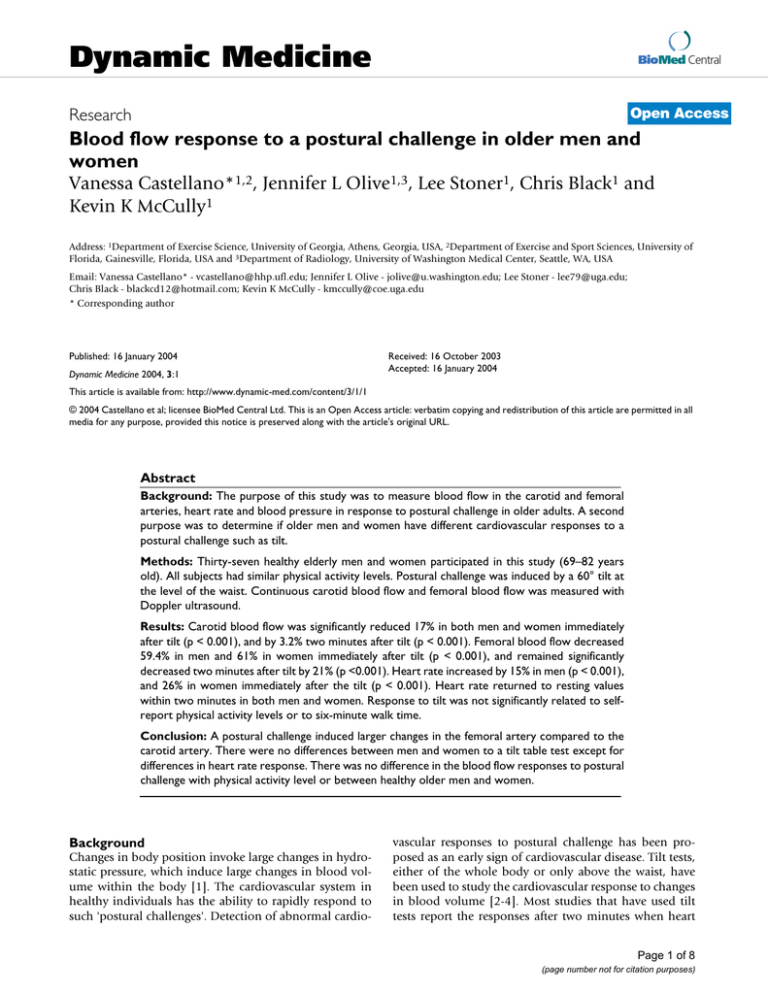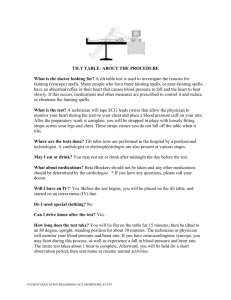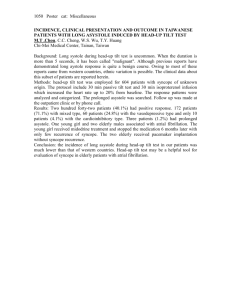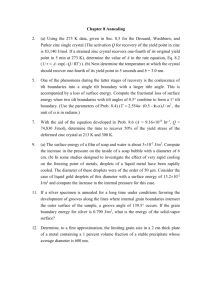Dynamic Medicine women Vanessa Castellano*
advertisement

Dynamic Medicine BioMed Central Open Access Research Blood flow response to a postural challenge in older men and women Vanessa Castellano*1,2, Jennifer L Olive1,3, Lee Stoner1, Chris Black1 and Kevin K McCully1 Address: 1Department of Exercise Science, University of Georgia, Athens, Georgia, USA, 2Department of Exercise and Sport Sciences, University of Florida, Gainesville, Florida, USA and 3Department of Radiology, University of Washington Medical Center, Seattle, WA, USA Email: Vanessa Castellano* - vcastellano@hhp.ufl.edu; Jennifer L Olive - jolive@u.washington.edu; Lee Stoner - lee79@uga.edu; Chris Black - blackcd12@hotmail.com; Kevin K McCully - kmccully@coe.uga.edu * Corresponding author Published: 16 January 2004 Dynamic Medicine 2004, 3:1 Received: 16 October 2003 Accepted: 16 January 2004 This article is available from: http://www.dynamic-med.com/content/3/1/1 © 2004 Castellano et al; licensee BioMed Central Ltd. This is an Open Access article: verbatim copying and redistribution of this article are permitted in all media for any purpose, provided this notice is preserved along with the article's original URL. Abstract Background: The purpose of this study was to measure blood flow in the carotid and femoral arteries, heart rate and blood pressure in response to postural challenge in older adults. A second purpose was to determine if older men and women have different cardiovascular responses to a postural challenge such as tilt. Methods: Thirty-seven healthy elderly men and women participated in this study (69–82 years old). All subjects had similar physical activity levels. Postural challenge was induced by a 60° tilt at the level of the waist. Continuous carotid blood flow and femoral blood flow was measured with Doppler ultrasound. Results: Carotid blood flow was significantly reduced 17% in both men and women immediately after tilt (p < 0.001), and by 3.2% two minutes after tilt (p < 0.001). Femoral blood flow decreased 59.4% in men and 61% in women immediately after tilt (p < 0.001), and remained significantly decreased two minutes after tilt by 21% (p <0.001). Heart rate increased by 15% in men (p < 0.001), and 26% in women immediately after the tilt (p < 0.001). Heart rate returned to resting values within two minutes in both men and women. Response to tilt was not significantly related to selfreport physical activity levels or to six-minute walk time. Conclusion: A postural challenge induced larger changes in the femoral artery compared to the carotid artery. There were no differences between men and women to a tilt table test except for differences in heart rate response. There was no difference in the blood flow responses to postural challenge with physical activity level or between healthy older men and women. Background Changes in body position invoke large changes in hydrostatic pressure, which induce large changes in blood volume within the body [1]. The cardiovascular system in healthy individuals has the ability to rapidly respond to such 'postural challenges'. Detection of abnormal cardio- vascular responses to postural challenge has been proposed as an early sign of cardiovascular disease. Tilt tests, either of the whole body or only above the waist, have been used to study the cardiovascular response to changes in blood volume [2-4]. Most studies that have used tilt tests report the responses after two minutes when heart Page 1 of 8 (page number not for citation purposes) Dynamic Medicine 2004, 3 rate and blood pressure have stabilized. Few studies, however, have evaluated the immediate cardiovascular response to tilt, which is important as the immediate responses are larger in magnitude than the stabilized responses, and may be more sensitive to changes in cardiovascular function [4-7]. While heart rate and blood pressure changes are routinely measured in response to postural challenge, actual changes in arterial blood flow have been less well studied. Approximately 75% of the blood flow to the brain comes from the common carotid arteries, thus, regulation of flow immediately after a postural challenge is highly regulated and very important to maintain function [8]. However, changes in the femoral artery might be expected to be just the opposite, with large changes in blood flow to assist in maintaining blood flow to the brain. Aging and cardiovascular disease can impair the speed and response of the cardiovascular system to postural challenge [4,9,10]. Gender may also influence vascular kinetics. Gender differences have been found in body weight, heart rate, stroke volume, and arterial compliance. For example, men have larger carotid arteries, and intimamedia thickness and wall stress of large arteries affecting blood flow are generally larger in men [11,12]. However, fluctuations in estrogen hormone levels in women affect arterial distensibility [13]. In addition, arterial stiffness, which has also been shown to be modulated by sex hormones, may affect blood flow velocity in conduit arteries [13]. These differences between men and women may affect systolic and diastolic blood pressure [12] as well as the ability to withstand cardiac events and respond to orthostatic stress [14,15]. Since gender may have a profound influence on the risk of cardiovascular disease and death, it is important to understand the effects of healthy aging and gender on autonomic control of the cardiovascular function [14]. The purpose of this study was to measure the immediate response of carotid and femoral artery blood flow, heart rate and blood pressure responses to postural challenge in older adults. A second purpose was to determine if there were gender differences in heart rate, blood pressure, or blood flow responses after a tilt in elderly individuals, and if levels of physical activity correlate with cardiovascular responses to tilt. Methods Subjects Thirty-seven subjects between the ages of 69 and 82 years volunteered to participate in the study. Nineteen subjects were male and eighteen subjects were female. All subjects had similar physical activity levels. All subjects reported being Caucasian except for one African-American female. http://www.dynamic-med.com/content/3/1/1 The subjects reported to the laboratory after eating a low fat meal, and did not take any medications the morning of the test. Eleven out of thirty-seven subjects took high blood pressure medication regularly, but did not take it the morning of the test. Only one subject was a smoker and eleven more reported being ex-smokers. Subjects were excluded from the study if they had a pacemaker, suffered from severe back pain, were under alpha-blocker medication or were diagnosed with heart disease six months prior to participating in the study. The study was conducted with the approval of the Institutional Review Board at the University of Georgia and written informed consent was obtained from all participants. Protocol The study included one testing session between 8:00– 11:00 am in a quiet, comfortable room (temperature 20– 22°C). The subjects rested for at least 10 minutes to allow stabilization, and then the testing procedure proceeded as follows. Postural Challenge Test The subjects were placed in a supine position for 5 minutes prior to testing. Baseline measurements were obtained for blood flow, heart rate, and blood pressure during 5 minutes of quiet rest. The tilt response was produced by manually lifting a hinged table 60 degrees in 1.5–2 seconds. Subjects were placed so that the hinge of the table corresponded to their waist. Subjects were not aware of when the tilt procedure was to be conducted. Once tilted, the subject was maintained in the upright position for 2 minutes while all measurements were being collected. The subject was then placed back in the supine position for at least 5 minutes or until all measurements stabilized, whichever was shorter. When all parameters stabilized, the tilt was repeated. The order of carotid and femoral artery blood flow measurements were alternated for different subjects throughout the whole experiment. Data for reproducibility was collected using several tilts to determine baseline measurements and the magnitude of change to tilt. Previous data collected in our laboratory suggested high levels of reproducibility of carotid and femoral measurements (≥95%) and no evidence of an order effect in repeated tilts (p > 0.05). Further, others have reported high reproducibility and sensitivity during heap-up tilt testing or blood flow testing using this technique [16,17]. Vascular Measurements Blood flow measurements of the right common carotid and femoral arteries were measured continuously by use of a quantitative Doppler Ultrasound (LOGIQ 400 CL, General Electric) [18]. A linear array transducer was used with frequencies of 6–9 MHz. The imaging sites were located 2–3 centimeters proximal to the carotid Page 2 of 8 (page number not for citation purposes) Dynamic Medicine 2004, 3 http://www.dynamic-med.com/content/3/1/1 Table 1: Subject Characteristics Age (yrs) Height (cm) Weight (kg) BMI (Kg/m2) Six-Minute Walk (m) Men (n = 18) Women (n = 17) P value 75.1 ± 4.2 174.6 ± 7.3 81.9 ± 11.5 26.9 ± 3.0 589 ± 83 74.9 ± 4.1 161.4 ± 6.2 70.9 ± 10.5 27.3 ± 5.0 490 ± 86 0.876 0.001* 0.005* 0.732 0.001* bifurcation in the right common carotid artery, and on the upper third of the thigh in the right superficial femoral artery. Diameters were measured in the axial view during diastole and B mode images were saved to magnetic optical disk for analysis. Images were later analyzed to determine vessel size. Pulsed Doppler ultrasound was recorded in the longitudinal view using an insonation angle between 50° – 60°. The velocity gate was set to include the entire arterial diameter. Time average maximum blood velocity (TAMAX) was measured for each cardiac cycle and recorded throughout the experiment. Blood flow was calculated as the product of vessel cross sectional area and the TAMAX. All subjects had ankle-brachial indexes (ratio of brachial artery systolic pressure over posterior tibial systolic pressure) determined after the postural challenge. mine relationships between variables. The level of significance was set at 0.05 for all statistical analyses and results were expressed as means ± standard deviation. Heart rate was measured continuously by a Biopac 1100 electrocardiogram (Biopac, Inc). Blood pressure was measured every thirty seconds with automated blood pressure devices (Colin 7000, Colin, Inc. and Accutor 3, Datascope Inc). Carotid Blood Flow Responses to Tilt Men and women had similar carotid artery blood velocities but men had significantly higher carotid blood flows (p < 0.05). In response to tilt, blood flow initially decreased and then returned to normal (Figure 1). There were no significant differences between men and women immediately after tilt (p = 0.429) or after 2 minutes (p = 0.204). When men and women were combined, carotid blood flow decreased by 17% immediately after tilt (p < 0.001) and remained 3.2% below initial values two minutes after tilt (p < 0.001). The average time for carotid blood flow to decrease to a minimum value after tilt was 25.4 ± 13.7 seconds (Figure 2). Carotid diameter did not change throughout the 2 minute tilt test (p > 0.05). Physical Fitness and Physical Activity The subjects performed a six-minute walk test in a quiet corridor to assess their levels of physical fitness. The subjects walked back and forth in a 50-meter corridor for six minutes at their own pace, and distance walked was calculated. Self-reported physical activity over the previous 30 days was recorded using the Yale Physical Activity Survey [19]. Activity was quantified by kilocalories and frequency of physical activity. Both measures, the six-minute walk and the Yale physical activity survey, were used to measure any correlations between physical activity and the cardiovascular responses to tilt. Statistical Analysis An independent t test was applied to determine if there were any differences between men and women on heart rate, blood pressure, or blood flow immediately or 2 minutes after tilt. A paired t-test was used to determine if there were any significant changes before and after tilt. Pearson product moment correlations were conducted to deter- Results Subject Demographics The physical characteristics and physical fitness of the subjects are shown in Table 1. There were no differences in age or health status between the older male and female subjects. The ankle brachial index for the tested leg averaged 1.28 (range of 0.91–1.72). There were no statistical difference in carotid arterial diameter between men and women (6.87 ± 0.75 mm for men, 6.48 ± 0.57 mm for women, p = 0.09). Men did have larger femoral artery diameters than the women (7.05 ± 1.03 mm for men, 5.66 ± 0.88 mm for women, p < 0.001). Femoral Blood Flow Responses to Tilt Women had significantly higher blood velocities at all time points (p < 0.05) but similar blood flow values (again due to the men having larger femoral artery diameters). In response to tilt, femoral artery blood flow decreased initially and remained reduced after two minutes (Figure 3). The initial decrease in femoral artery blood velocity was similar between the men (59%) and women (61%) immediately after tilt and after two minutes (21% for both men and women). With men and women combined the decrease in femoral artery blood Page 3 of 8 (page number not for citation purposes) Dynamic Medicine 2004, 3 http://www.dynamic-med.com/content/3/1/1 Figure 1of continuous blood velocity measurements in the carotid artery. Example Example of continuous blood velocity measurements in the carotid artery. Values are from a 71 year old female subject. Time zero on the x-axis represents the time when the tilt was performed. Figure 2of continuous blood velocity measurements in the carotid artery. Example Example of continuous blood velocity measurements in the carotid artery. Values are from a 71 year old female subject. Time zero on the x-axis represents the time when the tilt was performed. Page 4 of 8 (page number not for citation purposes) Dynamic Medicine 2004, 3 http://www.dynamic-med.com/content/3/1/1 Figure 3blood velocity values after tilt Femoral Example of continuous blood velocity measurements in the femoral artery. Values are from a 71 year old female subject. Time zero on the x-axis represents the time when the tilt was performed. Figure 4blood velocity values after tilt. Femoral Femoral blood velocity values after tilt. Femoral blood velocity was significantly reduced immediately and 2 minutes after tilt. However, the effect size was larger immediately after tilt (~58 seconds), than after 2 minutes of tilt. * p < 0.001 Page 5 of 8 (page number not for citation purposes) Dynamic Medicine 2004, 3 flow was highly significant (p < 0.001). The average time for femoral blood flow to decrease to a minimum value after tilt was 37.6 ± 21.5 seconds (Figure 4). Femoral diameter did not change throughout the 2 minute tilt test (p > 0.05). Heart Rate and Blood Pressure Responses to Tilt Heart rate increased by 15% in men (p < 0.001) and 26% in women (p < 0.001) immediately after the tilt. Women exhibited a significantly greater heart rate response than men immediately after tilt (p = 0.045). Heart rate returned to the initial pre-tilt values within two minutes in both men and women. Systolic and diastolic blood pressure responses immediately and after two minutes were similar in males and females. Thus, the blood pressure data was grouped together for the men and women for further analyses. Systolic blood pressure was significantly reduced by 25% immediately after tilt (p < 0.001), and by 5% after two minutes of tilt (p = 0.017). Diastolic blood pressure was significantly reduced by 14% after tilt (p < 0.001) but returned to resting values after two minutes (p = 0.087). Physical Activity The average walking distance was 541 meters (range of 320 to 778 meters). Self-reported physical activity averaged 4732 kcal/week (ranged of 1692 to 8892 kcal/week). Frequency of vigorous physical activity averaged 62 minutes/week (range of 27 to 103 minutes). There were no differences in self-reported physical activity between males and females. There were no significant correlations between physical capacity as measured by 6 minute walk time, blood flow, heart rate, or blood pressure responses to tilt. This was true for both men and women. Similarly, there were no significant correlations between the responses to tilt and physical activity levels as measured by kilocalories per week or the number of daily activities (Yale physical activity survey). Discussion The main finding of this study was that both carotid and femoral artery blood velocities decreased in response to postural challenge in healthy older adults, with the immediate responses being much greater than the two minute response. Immediate carotid and femoral blood flow responses upon tilt have not been studied well [16]. We found that blood flow reached minimum values approximately 30 seconds after tilt. However, there was a high degree of variability in the time to reach minimum values and more accurate measurements to determine the time course of changes may be useful. Our responses in the carotid artery after two minutes [20,21] and in the femoral artery after 1 or 2 minutes [22,23] are similar to those reported in previous studies. Femoral artery blood flow showed significantly larger changes after tilt than the carotid artery. http://www.dynamic-med.com/content/3/1/1 There were no gender-related differences in blood flow responses to postural challenge. However, some gender differences were seen in blood velocity and artery diameter. Men had larger femoral arteries and women had higher femoral blood velocities compared to the men. There was also a tendency for men to have larger carotid arteries as reported previously [11,12], although this finding was not significant. Nevertheless, the relative changes in blood velocity and blood flow were similar between men and women in both the carotid and femoral arteries. The lack of gender differences in blood flow response to tilt was unexpected, as previous studies have reported gender differences in response to tilt heart rate, blood pressure, and in sympathetic nerve activity [22,24]. Females had a greater increase in heart rate than males immediately upon tilt. This response is consistent with literature in which females show higher resting heart rates than males [2], and larger increases in heart rate due to a postural stress [2,12,25-28]. Reports by Imadojemu et al. [22] and Morgan et al. [23] also chose to combine their male and female subjects in their presentation of blood flow responses to tilt, supporting our lack of gender differences in blood flow. Consistent with previous studies, we found that tilt produced transient increases in heart rate [2,12,26-29]. The changes in heart rate in our study were lower than some previously reported literature and may be due to a tilt from the waist only [4,29]. We chose to use a passive tilt test from the waist only to allow measurement of femoral artery blood flow and to minimize the chance of subjects having syncope. Previous studies have shown that whole body tilt tests in frail older subjects can produce syncope in up to 50% of the cases. However, in our study of relatively healthy older adults using only waist tilt, no subjects reported any symptoms of syncope. In addition, there are no reports in the literature investigating immediate responses of blood flow to tilt. This is probably due to the challenging nature of the measurements since this test includes a dynamic measurement of the carotid and femoral arteries. Kojo et al. [16] studied healthy young subjects and pediatric patients suffering from syncope by measuring carotid blood flow after a 60 degree tilt. Most of these young patients (50% of young healthy and 88% of syncopal pediatric patients) also experienced significant decreases in carotid blood flow due to tilt. However, their measurements were collected every minute after tilt during 20 minutes, and did not study the rapid changes of carotid blood flow immediately after tilt in this population [16]. Thus, our study reports measurements in an area that has not been explored extensively, and provides novel results in carotid and femoral blood flow immediately (within seconds) after a 60 degree tilt. Page 6 of 8 (page number not for citation purposes) Dynamic Medicine 2004, 3 We did not find any associations between physical activity levels or walking distance and the responses to tilt. This was despite finding a large range of fitness levels and activity histories, and using both self-reported activity levels and directly measured walking distances (timed 6 minute walk test). A previous study using the cardiovascular response to a hand cold pressor test suggested that fitness level was inversely related to changes in systolic blood pressure but not to total peripheral vascular resistance [30]. However, this study also found that fitness levels were unrelated to changes in total peripheral vascular resistance in response to the cold pressor test. Conclusions http://www.dynamic-med.com/content/3/1/1 References 1. 2. 3. 4. 5. 6. In summary, a 60° tilt at the waist produced large changes in carotid and femoral blood flow, heart rate, systolic and diastolic blood pressure. Larger blood flow changes occurred immediately after tilt compared to two minutes after tilt. There were no differences between men and women to a tilt table test except for differences in heart rate response. Tilt at the waist did not produce syncope in any older adults participating in this study, which is common problem in this population if whole body tilt is used. Thus, this study demonstrated that immediate blood flow responses after a modified tilt table test are attainable. This method could prove to be a useful tool for determining cardiovascular disease risk with further research and development. Another interesting observation is that since we only acquired information on the common carotid artery blood flow, the results may be blunted due to the nature of this artery, where the blood is carried to various regions of the head (e.g. eye, brain). Perhaps the monitoring of the internal carotid artery alone would provide even more valid information on how blood flow to the brain is affected during a postural stress such as tilt. 15. List of abbreviations 16. TAMAX – Time average maximum velocity 7. 8. 9. 10. 11. 12. 13. 14. 17. Author's contributions VC participated in the study design and data collection, coordinated the study, carried out the statistical analysis, and drafted the manuscript. JO coordinated the study and data collection, carried out the statistical analysis, and drafted the manuscript. LS participated in data collection and coordination of the study. CB participated in data collection and coordination of the study. KM participated in the study design, coordinated the study, carried out the statistical analysis, and drafted the manuscript. All authors read and approved the final manuscript. 18. 19. 20. 21. 22. Acknowledgements We would like to thank all the volunteers that participated in this study. Financial support provided by NIH grant HL65179 23. Convertino V: Exercise and adaptation to microgravity environments. Handbook of Physiology: adaption to the environment Edited by: Fregly J and Blatteis C. Bethesda, Amer. Physiol. Soc.; 1997. Frey MA, Tomaselli CM, Hoffler WG: Cardiovascular responses to postural changes. Differences with age for women and men. Journal of Clinical Pharmacology 1994, 34:394-402. Fagard R, Thijs L, Amery A: Age and the hemodynamic response to posture and exercise. American Journal of Geriatric Cardiology 1993, 2:23-40. Goldstein IB, Shapiro D: The cardiovascular responses to postural change as a function of race. Biological Psychology 1994, 23:172-186. Nardo CJ, Chambless L, Light K, Rosamond W, Sharrett AR, Tell GS, Heiss G: Descriptive epidemiology of blood pressure response to change in body position. Hypertension 1999, 33:1123-1129. Light KC: Differential responses to salt-interactions. Individual responses in cardiovascular response to stress Edited by: Plenum. New York; 1995:245-263. Streicher W, Misner JE, Bloomfield DK, Massey BH: Hemodynamic responses to positional change in habitually physically active and inactive older men. J Am Geriatr Soc 1998, 36:795-800. Zwiebel WJ: Introduction to vascular ultrasonography. Philadelphia, Saunders; 2000. Wieling W: Orthostatic stress and autonomic function. Autonomic failure, a textbook of clinical disorders of the autonomic nervous system Edited by: Bannister R ed. Oxford University Press; 1988: 308-321. Turner JR: Cardiovascular reactivity and stress: patterns of physiological response. New York; 1994:58-59. Denarie N, Gariepy J, Chironi G, Massonneau M, Laskri F, Salomon J, Levenson J, Simon A: Distribution of ultrasonographicallyassessed dimensions of common carotid arteries in healthy adults of both sexes. Atherosclerosis 2000, 148:297-302. Smulyan H, Asmar RG, Rudnicki A, London GM, Safar ME: Comparative effects of aging in men and women on the properties of the arterial tree. J. Am. Coll. Cardiol. 2001, 37:1374-1380. Le Gal G, Gourlet V, Hogrel P, Plu-Bureau G, Touboul PJ, Scarabin PY: Hormone replacement therapy use is associated with a lower occurrence of carotid atherosclerotic plaques but not with intima-media thickness progression among postmenopausal women. The vascular aging (EVA) study. Atherosclerosis 2003, 166:163-170. Barnett SR, Morin RJ, Kiely DK, Gagnon M, Azhar G, Knight EL, Nelson JC, Lipsitz LA: Effects of age and gender on autonomic control of blood pressure dynamics. Hypertension 1999, 33:1195-1200. Watanabe M., Mano, K., Watanabe, H., Koike, Y.: Effects of age and sex on orthostatic change in blood pressure in normal persons. Rinsho Shinkeigaku 1996, 36:1175-1178. Smith J, Porth C, Erickson M: Hemodynamic response to the upright posture. Journal of Clinical Pharmacology 1994, 34:375-386. Alehan D, Celiker A, Ozme S: Head-up tilt test: a highly sensitive, specific test for children with unexplained syncope. Pediatr Cardiol 1996, 17:86-90. Olive J, DeVan A, McCully K: The effects of aging and activity on muscle blood flow. Dynamic Medicine 2002, 1(2):. DiPietro JA, Ewert KE, Todd KS: A survey for assessing physical activity among older adults. May. Med Sci Sports Exerc. 1993, 25:628-642. Kojo M, Wada M, Akiyoshi K, Inutsuka M, Izumi T: Reduction of carotid artery blood flow in pediatric patients with syncope: evaluation with head-up tilt test. Neuropediatrics 2001, 32:169-175. Takeshita S., Nagai, H., Fujisawa, T., Sekine, Y, Yoshioka, S. . J.: The usefulness of the measurement of carotid artery blood flow in patients with orthostatic dysregulation by pulsed-doppler evaluation. Jpan. Pediat. Soc. 1994, 98:120-121. Imadojemu VA, Lott ME, Gleeson K, Hogeman CS, Ray CA, Sinoway LI: Contribution of perfusion pressure to vascular resistance response during head-up tilt. Am. J. Physiol. Heart Circ. Physiol. 2001, 281:H371-H375. Morgan R.H., Psaila, J.V., Stone, J., Carolan, G.: Effect of postural change on common femoral artery blood flow, measured by duplex ultrasound, in normal subjects and patients with peripheral vascular disease. J Biomed Eng May 1991, 13:244-248. Page 7 of 8 (page number not for citation purposes) Dynamic Medicine 2004, 3 24. 25. 26. 27. 28. 29. 30. http://www.dynamic-med.com/content/3/1/1 Dishman RK, Nakamura Y, Jackson EM, Ray CA: Blood pressure and muscle sympathetic nerve activity during cold pressor stress: fitness and gender. Psychophysiology 2003, 40:370-380. Shoemaker JK, Hogeman CS, Silber DH, Gray K, Herr M, Sinoway LI: Head-down-tilt bed rest alters forearm vasodilator and vasoconstrictor responses. Journal of Applied Physiology 1998, 84:1756-1762. Abdel-Rahman AR, Merrill RH, Wooles WR: Gender-related differences in the baroreceptor reflex control of heart rate in normotensive humans. Journal of Applied Physiology 1994, 77:606-613. Girdler SS, Light KC: Hemodynamic stress responses in men and women examined as a function of female menstrual cycle phase. International Journal of Psychophysiology 1994, 17:233-248. Gotshall R, Tsai P, Frey M: Gender based differences in the cardiovascular response to standing. Aviation, Space, and Environmental Medicine 1991, 62:855-859. Shoemaker J.K., Hogeman, C.S., Khan, M., Kimmerly, D.S., Sinoway, L.I.: Gender affects sympathetic and hemodynamic response to postural stress. Am. J. Physiol. Heart Circ. Physiol. 2001, 281:H2028-H2035. Dishman RK, Jackson EM, Nakamura Y: Influence of fitness and gender on blood pressure responses during active or passive stress. Psychophysiology 2002, 39:568-576. Publish with Bio Med Central and every scientist can read your work free of charge "BioMed Central will be the most significant development for disseminating the results of biomedical researc h in our lifetime." Sir Paul Nurse, Cancer Research UK Your research papers will be: available free of charge to the entire biomedical community peer reviewed and published immediately upon acceptance cited in PubMed and archived on PubMed Central yours — you keep the copyright BioMedcentral Submit your manuscript here: http://www.biomedcentral.com/info/publishing_adv.asp Page 8 of 8 (page number not for citation purposes)







